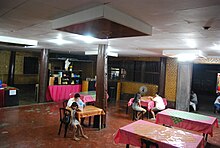This article has multiple issues. Please help improve it or discuss these issues on the talk page. (Learn how and when to remove these messages)
|
| Vega Ancestral House | |
|---|---|
 Vega Ancestral House Vega Ancestral House | |
 | |
| General information | |
| Type | Heritage House |
| Architectural style | 1st Transition Bahay na Bato |
| Location | Poblacion, Balingasag, Misamis Oriental, Northern Mindanao (Region X), Philippines |
| Coordinates | 8°44′36″N 124°46′37″E / 8.7433°N 124.7769°E / 8.7433; 124.7769 |
| Completed | 1800s |
| Technical details | |
| Material | "Molave", "Balayong" and "Tugas" (Visayan) |
| Website | |
| Vega Ancestral House | |
The Vega Ancestral House is one of the earliest Transition bahay na bato-inspired structures still standing, having endured various colonial periods of the Philippines for an estimated 200 years. The house is located in Población, Balingsag, Misamis Oriental.
Its sculpted wooden atlases, known as otí-ot in the Visayan language, support the second floor protrusion of the house. The house is a well-known landmark among the locality's tourist attractions. Notable personalities including Emilio Aguinaldo and Sergio Osmeña are said to have stayed in the house.
History
In the 1800s, Ignacio Juan Vega from San Nicolas, Cebu named settled in Northern Mindanao at a small town now called Balingasag, then named Galas. Vega introduced the Cebuano devotion to the Sto. Niño to the townsfolk of Balingasag. Aside from this cultural practice, he also left behind a heritage house that is considered these days as a landmark in Misamis Oriental.
The house also witnessed the political endeavors of its owners. The first town executive came from the Vega Clan, Faustino Vega. He was known as the presidente local under the short-lived First Philippine Republic (1898–1903). Melquiades Vega, Faustino Vega's son, served as the first presidente local under the American Regime (1903-1928).
Though no existing documents pinpoint the exact year of construction, several attempts by heritage advocates to document this house, as well as bloggers and local townspeople, suggest that it was built in the 1800s.
House features

The house is designed with sculpted wooden figures that act as support structures to the protruding second floor. There are three wooden figures, with one corner lacking such a structure.

There are varying interpretations regarding the three sculpted wooden figures. Some suggest they represent slavery, while others believe they are inspired by the Atlas icon symbolizing a man carrying the world. According to Dr. Antonio J. Montalvan II, referencing the Vega Clan genealogy, the three sculptures represent the three sons of Ignacio Juan Vega: Santos (married to Valentina Roa, Juana Valmores), Pedro (married to Benita Salvacion), and Gregorio.

The house primarily uses "molave" and "balayong" wood. Large beams or pillars support the overall stability of the house structure, placed at the corners, between corners, and along the center. The walls resemble woven abaca, called "Uway" (English: rattan) in Visayan, and are colored yellow. The house still utilizes the traditional banggera (kitchen dishwashing area) as an air-drying shelf for kitchen wares and utensils.

The uppermost portion of the house features a classical cogon roof. This, along with the emerging stone works at the bottom part of the house, classifies the house under the 1st Transition of Bahay na bato. The support beams are decorated with the chambered nautilus motif.
The high quality of materials used in construction is evidenced by the house's resilience through the centuries. This heritage structure is one of the primary attractions for tourists visiting the historical center (Poblacion) of Balingasag.
Tourism
Coffee table books and glossy calendars (such as the 2006 Shell calendar ) contribute to the house's visibility and the municipality's tourism.

According to Ms. Nanette Vega, the local tourism authority has expressed interest in acquiring the house to preserve and open it as a tourism hotspot. The Vega clan has declined the proposal for sentimental reasons, preferring to maintain the house themselves despite the costs. The house remains open for walk-in tourists and visits by appointment.
The house's association with Maria Clara Vega Jimenez—mother of television personality Inday Badiday and Philippine Daily Inquirer editor-in-chief Letty Jimenez Magsanoc—adds to its fame. It is locally known as the "Vega House," not the "Jimenez House." Some mistakenly associate the house with the late child star Julie Vega due to her stage surname. However, her real name was Julie Pearl Apostol Postigo.
Present Times

The first floor of the house currently operates as a restaurant/carinderia, open from 6:00 am to 7:00 pm. Part of the income contributes to the house's maintenance.
Neighboring Heritage Houses
See also
References
- "Heritage Structures in Misamis Oriental". Retrieved May 18, 2014.
- ^ Montalvan II, Antonio. "Karaang Balay: Shifting Meanings in the Heritage Houses of Northern Mindanao". MINDAyawan Journal of Culture and Society. Capitol University. Retrieved 20 Aug 2023.
- "Heritage Structures in Misamis Oriental by Dr. Antonio J. Montalvan II.Heritage Conservation Advocates, Cagayan de Oro, Philippines.Published on January 10, 2006". Retrieved May 18, 2014.
- "Talking about "Julie Vega"". Archived from the original on 2007-09-29. Retrieved 2007-06-18.
External links
- "Weekend Getaway: The Vega House, Balingasag, Misamis Oriental", travel blog with photos
- "The Vega Ancestral House in Balingasag, Misamis Oriental", travel blog with photos
- "The Vega House: An Ancestral House in Balingasag", travel blog with photos
- "I love balingasag" photo








